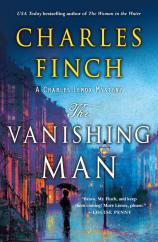The Vanishing Man: A Charles Lenox Mystery
Review
The Vanishing Man: A Charles Lenox Mystery
Time traveling to 1853, UNCLE TOM’S CABIN has made its way across the pond, to London, where Charles Dickens has published his ninth novel, BLEAK HOUSE. Abraham Lincoln is eight years shy of being inaugurated America’s first Republican president, and 10 years preceding his revolutionary Emancipation Proclamation. Queen Victoria has reigned for 16 years.
On “a warm, beautiful, windy day in early June of 1853,” the 15th Duke of Dorset --- confidant to the Queen --- “has discovered that a possession upon which he places high value is missing.” The duke summons novice private investigator Charles Lenox to Dorset House, a mansion that rivals one of the Queen’s palaces. Why not engage, however, a slew of sleuths at Scotland Yard? “Lenox was a tall, slender, straight-backed young bachelor of 26, bearing a gentlemanly appearance,” with only one amateur case notched into his belt, that being 2018’s THE WOMAN IN THE WATER, the first of this prequel trilogy.
"Perhaps [Finch's] observations as a reviewer prompted a toned-down Charles Lenox. After all, one proficient in a craft constructs a sound foundation before achieving a career culmination."
The duke educates Lenox to the family’s history, mentioning that a portrait of a forebear duke has gone missing. He muses that the painting is of little consequence and may have been inadvertently pinched, an infinitely rare oil portrait of William Shakespeare displayed adjacent to it. A bizarre kidnapping precedes an apparent murder, both of which seem related to the purported manuscript of Shakespeare’s final play.
The novice investigator learns of Thaddeus Bonden, reputed to have superior divining skills, who teaches Lenox sleuthing techniques and how to hide in plain sight. “He didn’t know where he was going; he didn’t know enough to know quite what he knew.” Instrumental in learning the craft, Lenox has a “notebook he kept of the errors he made,” though true detective work takes a back seat. Etymology seems to be a primary focus: Within a century, the 13th-century asylum “Our Lady of Bethlehem…had been shortened to Bethlem. By 1440 it was called, thanks to the local accents, Bedlam.” That and a host of Victorian Era minutiae fill the pages but not the literary soul.
Still, Lenox relies on visceral emotional reaction, what detectives now call gut feeling. The intuition is there, evidenced by the excellent structure that precedes the prequels. He “knew in his bones that something closer to murder than manslaughter had occurred.” Lenox, in sleuthing infancy, “thought a case such as this one would reach its conclusion and every last string would be tied off. But what do we have now? It is thoroughly unsatisfying.”
USA Today bestselling author Charles Finch has published 13 novels. He received the 2017 Nona Balakian Citation Award, for excellence in reviewing, from the National Book Critics Circle. Perhaps his observations as a reviewer prompted a toned-down Charles Lenox. After all, one proficient in a craft constructs a sound foundation before achieving a career culmination.
Reviewed by L. Dean Murphy on February 22, 2019
The Vanishing Man: A Charles Lenox Mystery
- Publication Date: January 14, 2020
- Genres: Fiction, Historical Fiction, Historical Mystery, Mystery
- Paperback: 320 pages
- Publisher: Minotaur Books
- ISBN-10: 1250311373
- ISBN-13: 9781250311375




